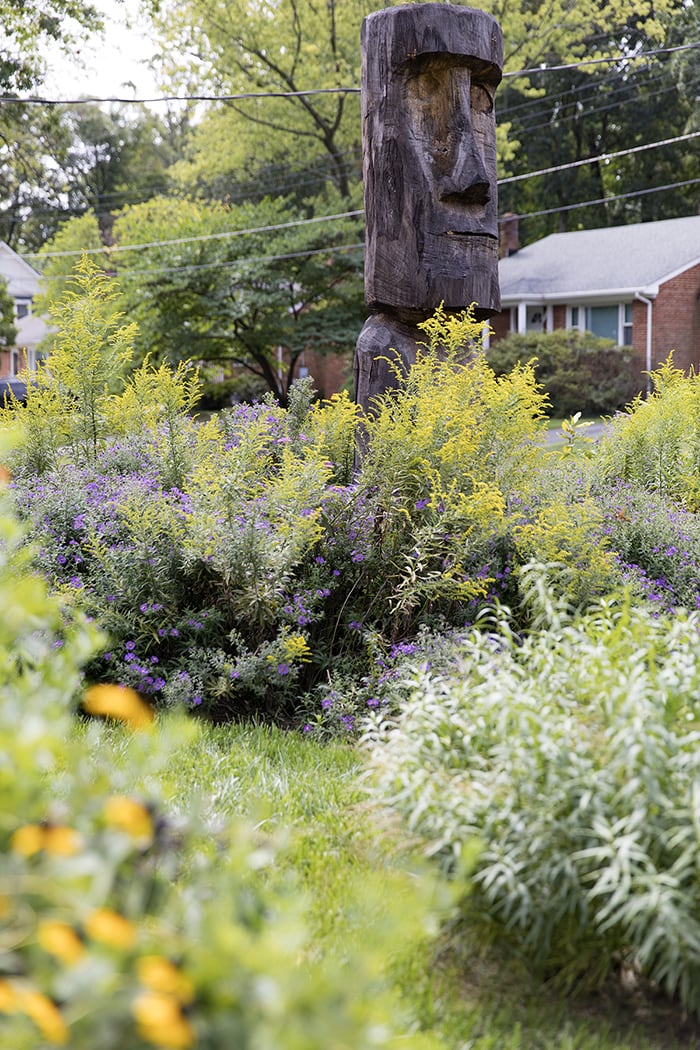NECTAR SOURCES FOR LARGE-WINGED BUTTERFLIES
OF THE MID-ATLANTIC
Ooooo, a monarch! It takes an erratic path across the garden, bright orange wings gliding and flapping, drifting and fluttering. It floats down and lights on a stalk of common milkweed and after a momentary pause, the dark abdomen curls and a single egg is precisely laid underneath a small, tender leaf. She repeats the process twice more. The mother butterfly discovers another stand of young shoots on the opposite side of the garden and continues her delicate dance. An egg here. Flutter flutter. Another egg gently placed there.
Three years have quickly passed since I planted tiny milkweed plants and they now command ample portions of this wildlife habitat, creating a welcoming haven for monarchs—adults and larvae alike. It’s mid-summer, with clear skies and still air; the perfect conditions for butterfly spying.
Scrutinizing the plants that make up this front yard garden, I stand in the warming sun and consider whether there’ll be sufficient nectar for any new monarchs when nearly a month from now the miraculous four stage metamorphosis, from egg to larva to pupa to butterfly, is complete.
The smaller butterflies such as skippers and fritillaries frequent a wide variety of flowers but the large-winged beauties, I’ve noticed, are slightly more discerning. What flowers do they want? This question sent me on the most colorful of journeys …

Are you gonna eat that?
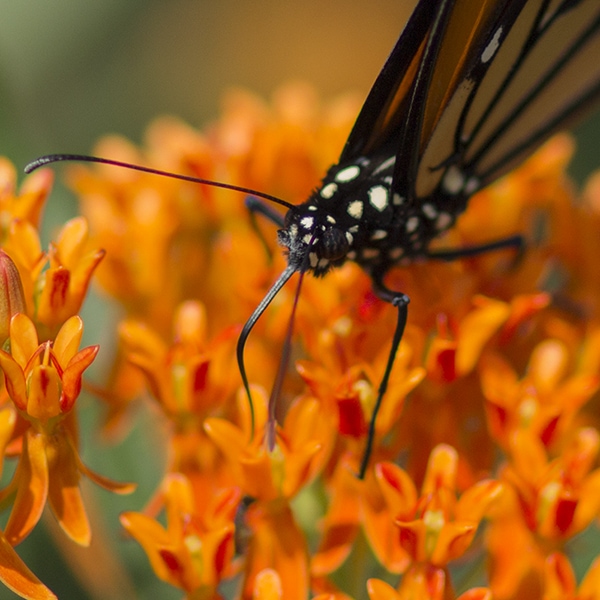
Most butterflies live on nectar from flowers and some also receive nourishment from pollen, tree sap, rotting fruit, carrion, dung, aphid honeydew and minerals found in wet sand or dirt. They have a proboscis, a long complex food canal that is straw-like and coiled when not in use. Proboscises come in different lengths and can dictate which flower a butterfly may drink from.
What else might make one flower more alluring to a particular butterfly than the next? Scent and color can be enticing components. Some researchers also identified butterfly morphology as a factor; they found that species with a “high wing load” generally preferred clustered or nectar-rich flowers. This would explain all the swallowtails on Joe Pye Weed!
You may be tempted to plant butterfly bush (Buddleja spp. and cultivars) because you notice your neighbor’s attracts butterflies late in the growing season. Please resist the urge to do so! Butterfly bush is an introduced plant from Asia that does not support local food webs. It’s also an invasive shrub that outcompetes native flora for resources and negatively impacts all our wildlife. Some prudent states have taken steps to ban the sale of butterfly bush.
FROM EGG TO ADULT:
Support a butterfly’s full life cycle
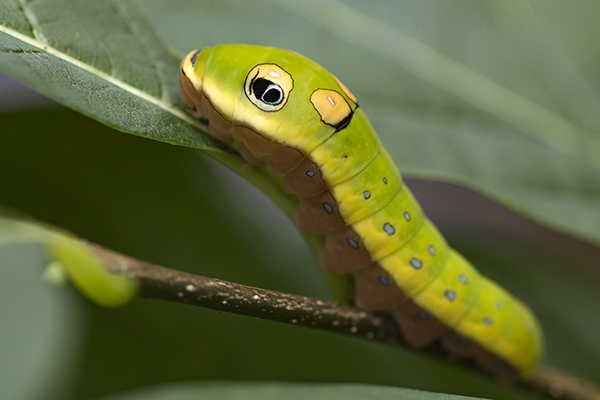
While wildflower nectar is a necessary habitat component for butterflies, other plant life such as native grasses, vines, shrubs and trees are equally crucial for food and shelter. A landscape with tons of plant diversity will help not only butterflies but also our other wild critters— great and small and every life in between.
Let’s grow butterflies! It’s easy to do: just add the plant that their larvae will eat. These specific plants that caterpillars need for food are called host plants. Monarchs, as we know, require milkweed or Asclepias species to reproduce. Host plants are not optional for caterpillars and some, like those of the zebra swallowtail, the pipevine swallowtail and the monarch, have only one genus of plant that they can eat. What Do Caterpillars Eat? by the Washington Area Butterfly Club lists some common butterflies and their typical host plants.
Did you know that butterflies need water, too? You can provide essential moisture and minerals by filling a shallow dish with damp sand or mud. It’s a bit of maintenance but well worth it if you spy even a tiny skipper taking a drink, as I have. And don’t forget to leave the leaf litter! There are butterfly and moth species that overwinter as egg, larva or pupa in the blanket of fallen leaves and debris. Let’s not be tossing out the butterflies we’re trying to encourage.
FLOWER POWER!
Here the spotlight is thrown on a handful of sun-loving native herbaceous plants that large–winged butterflies such as the monarch and swallowtails have been observed to frequent. The bloom times are varied, beginning in early summer and ending in fall, when late-season nectar is crucial for migrating butterflies.
These lovely plants will naturally support smaller butterflies, native bees and insects, as well as other animals throughout the food web. If the plant is a known Lepidoptera (butterfly and moth) caterpillar host, that information from Doug Tallamy’s research is included as well. Remember to choose native plant species that occur naturally in your area to keep wild areas functioning. Happy butterfly watching!
I do not include plant hardiness zone information because if you’re planting regionally native plants, as I hope you are, that information is unnecessary.

Common Milkweed (Asclepias syriaca)
Height: 3 – 5 ft, up to 8 ft
Bloom time: June – August
Sun: Full
Moisture: Medium to Low
Soil: Medium to fine sandy, clay, well-drained loamy, rocky calcareous; pH moderate
Natural habitat: Fields, pastures, roadsides
Notes: The large leaves of this Asclepias species are sought by monarchs looking to lay their eggs. The USDA Forest Service writes: “Common milkweed is Nature’s mega food market for insects. Over 450 insects are known to feed on some portion of the plant.”
Some gardeners consider A. syriaca to be a thug because it spreads by rhizomes and can colonize areas including lawn. Any shoots that pop up where they’re not wanted, though, are easy to pull or cut.
Milkweeds are host to 12 species of native caterpillars including the monarch butterfly.
Other options: Swamp milkweed (Asclepias incarnata) is a moisture-loving species that does not spread by rhizomes.
More information: USDA Forest Service Plant of the Week: Asclepias syriaca
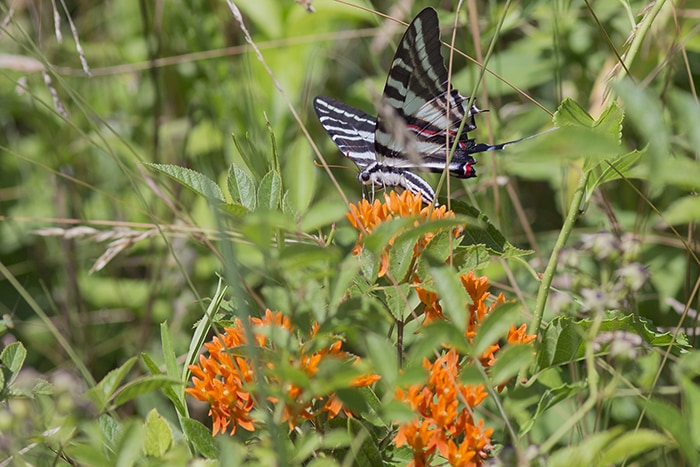
Out in the wild: a zebra swallowtail on butterfly weed (Asclepias tuberosa).
Zebra swallowtails have only one host plant: paw paw (Asimina triloba).
Butterfly Weed (Asclepias tuberosa)
Height: 1 – 3 ft
Bloom time: May – August
Sun: Full
Moisture: Low
Soil: Rocky, poor, well-drained; pH moderate
Natural habitat: Dry open woodlands, fields, roadsides
Notes: Butterfly weed has grown successfully in well-drained clay in my Northern Virginia garden.
It’s best to give thought to where it’s planted because the large taproot doesn’t like to be transplanted once established.
Deer don’t typically browse Asclepias foliage but they may gobble up the tender seed pods, milkweed bugs and all.
Host to 12 native butterfly and moth species, including the monarch.
More information: Virginia Native Plant Society 1992 Wildflower of the Year: Asclepias tuberosa

Eutrochium spp. covered in swallowtails. Tiger swallowtails have many host plants including black cherry (Prunus spp.), willow (Salix spp.) and basswood (Tilia spp.) trees. Photo by miss-myers/flickr/cc.
Hollow Joe Pye Weed (Eutrochium fistulosum)
Height: 5 – 7 ft, can grow taller
Bloom time: May – August
Sun: Full, Part, Shade
Moisture: Medium
Soil: Rich
Natural habitat: Floodplain forests, alluvial and seepage swamps, riverbanks, wet meadows, ditches
Notes: The frothy flowers are some of the best for attracting pollinators.
Song birds eat the ripened seeds.
Eutrochium spp. are host to 42 species of native caterpillars.
Other options: Sweet Joe Pye Weed (Eutrochium purpureum), Spotted Joe Pye Weed (Eutrochium maculatum), Three-nerved Joe Pye Weed (Eutrochium dubium)
More information: Maryland Native Plant Society Wildflowers in Focus: Joe Pye Weed

Wild Bergamot (Monarda fistulosa)
Height: 1 – 5 ft
Bloom time: June – August
Sun: Full, Part
Moisture: Medium, Medium-Low
Soil: Adaptable, rocky, rich, sand, clay
Natural habitat: Mesic to dry upland forests, rocky woodlands, clearings, forest edges, meadows, fields, roadsides
Notes: Bumblebees, hummingbird moths and hummingbirds also frequent wild bergamot.
It colonizes by rhizomes but it’s easy to control.
Monarda spp. are host to seven species of native caterpillars.
Other options: the red-flowered Bee Balm (Monarda didyma)
More information: Virginia Native Plant Society 1993 Wildflower of the Year: Wild Bergamot

A monarch on New England aster (Symphyotrichum novae-angliae). Photo by David Marvin/flickr/cc.
New England Aster (Symphyotrichum novae-angliae)
Height: 1 – 6 ft and taller
Bloom time: August – October
Sun: Full, Part
Moisture: Medium
Soil: Adaptable, rich, sand, loam, clay
Natural habitat: Moist, open woods, wet meadows, stream banks, alluvial fields
Notes: New England aster has a long bloom period and is enjoyed by many insects.
It can get leggy in a garden setting; some gardeners continually pinch it back before July to control its height, but note that the blooms may open later.
New England aster reseeds abundantly! Share with neighbors!
Asters are known to host 112 species of native caterpillars.
Other options: Aromatic Aster (Symphyotrichum oblongifolium), New York Aster (Symphyotrichum novi-belgii)
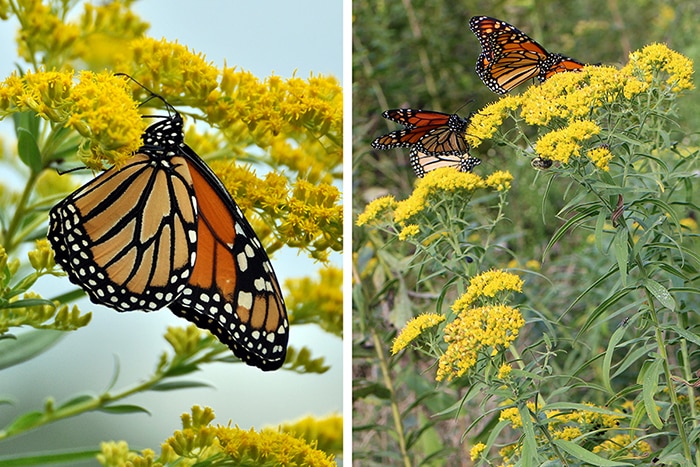
Goldenrod (Solidago spp.) at left and grass-leaved goldenrod (Euthamia graminifolia) on right.
Photos by Putneypics/flickr/cc & Lisa Bright/Earth Sangha.
Showy Goldenrod (Solidago speciosa)
Height: 1 – 6 ft
Bloom time: August – October
Sun: Full
Moisture: Medium, Low
Soil: Adaptable, loam, clay
Natural habitat: Dry, open forests, woodlands, clearings, roadbanks
Notes: Goldenrods are for pollinators; hummingbirds have also been observed sipping nectar.
Plant goldenrod with purple asters for a fabulous fall display.
Solidago spp. are host to 115 species of native caterpillars. Euthamia spp. host five.
Other options: There are many species of goldenrod adapted to varying habitats. Here are some sun-loving options: Early Goldenrod (Solidago juncea), Sweet Goldenrod (Solidago odora), Tall Goldenrod (Solidago altissima), Rough-stemmed Goldenrod (Solidago rugosa), Gray Goldenrod (Solidago nemoralis), Grass-leaved Goldenrod (Euthamia graminifolia)
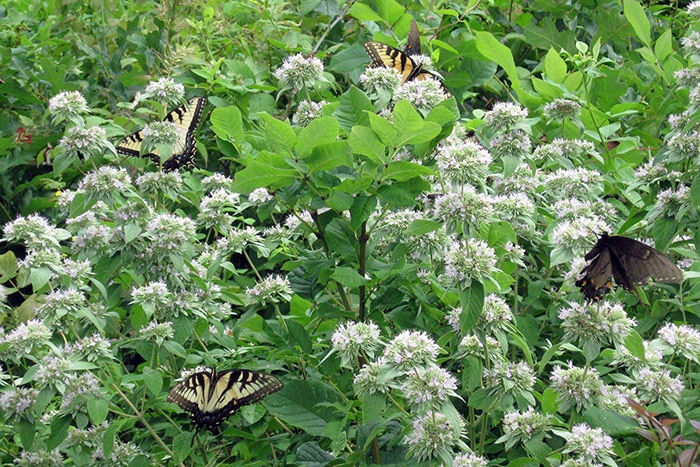
Hoary mountain mint (Pycnanthemum incanum) growing in a natural area.
The swallowtails are delighted! Photo by Lisa Bright/Earth Sangha.
Hoary Mountain-Mint (Pycnanthemum incanum)
Height: 2 – 6 ft
Bloom time: June – July
Sun: Sun, Part
Moisture: Medium, Dry
Soil: Loam, sand, rocky, well-drained; pH acid-based
Natural habitat: Forests, forest borders, rocky woodlands, clearings, roadsides
Notes: Deer resistant like most plants in the mint family, (Lamiaceae).
Pycnanthemums are host to three species of butterflies and moths.
Other options: There are many Pycnanthemum species; Clustered Mountain-Mint (Pycnanthemum muticum) is another fine choice for luring swarms of pollinators.

Blue Mistflower (Conoclinium coelestinum)
Height: 1 – 2 ft
Bloom time: August – September
Sun: Sun, Part
Moisture: High, Medium
Soil: Moist loam, sand, clay
Natural habitat: Floodplain forests, stream banks, swamps, moist to wet meadows, clearings
Notes: Spreads quickly by rhizomes and self-sowing in optimum conditions; easily lifted to share with friends and neighbors.
Skippers and small pollinators enjoy mistflower as much as the larger butterflies.
Usually deer resistant.
Although not a known Lepidoptera host plant, mistflower is nonetheless an important habitat plant.
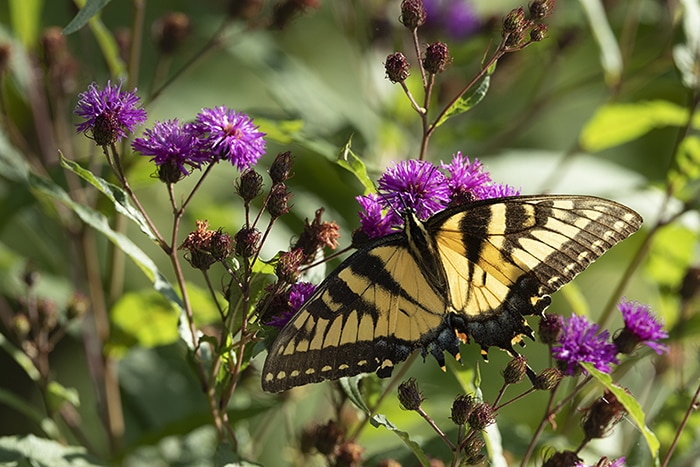
Pretty New York ironweed (Vernonia noveboracensis) and eastern tiger swallowtail.
New York Ironweed (Vernonia noveboracensis)
Height: 3 – 8 ft
Bloom time: July – September
Sun: Full, Part
Moisture: High, Medium
Soil: Rich, adaptable; pH acid to neutral
Natural habitat: Floodplain forests, alluvial swamps, riverbanks, wet meadows, low fields, tidal swamps
Notes: Seedheads attract birds such as goldfinches.
Vernonia spp. are host to 19 species of Lepidoptera.
Other options: Broad-leaf Ironweed (Vernonia glauca); this species requires less moisture than New York ironweed.
More information: Virginia Native Plant Society 1995 Wildflower of the Year: New York Ironweed
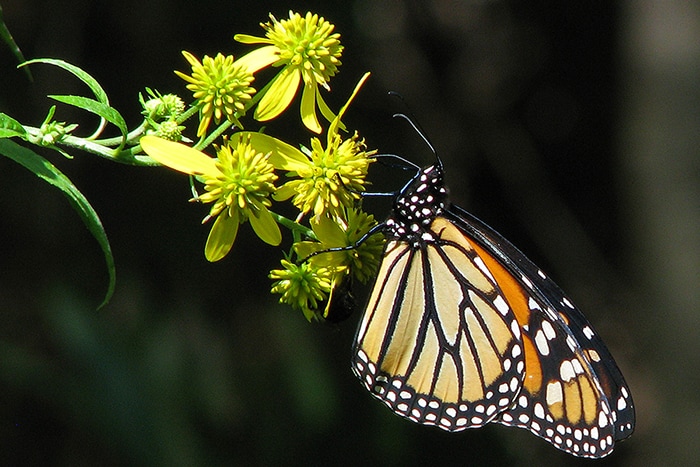
Wingstem (Verbesina alternifolia). Photo by Vicky DeLoach/flickr/cc.
Wingstem (Verbesina alternifolia)
Height: 3 – 10 ft
Bloom time: August – October
Sun: Full, Part
Moisture: High, Medium
Soil: Rich
Natural habitat: Floodplain forests, alluvial swamps, riverbanks, low meadows, fields
Notes: Wingstem is a prolific self-seeder.
The rough leaves help make this plant deer resistant.
Sixteen native caterpillar species are hosted on Verbesina.
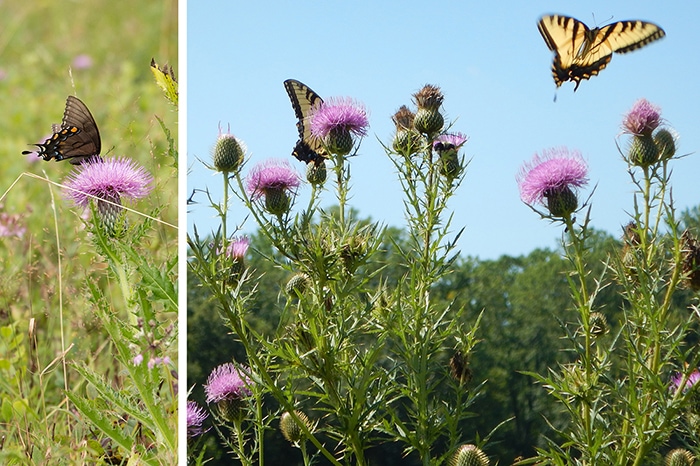
Pasture thistle (Cirsium pumilum) on the left and field thistle (Cirsium discolor), a taller-growing species, on the right. C. discolor photo by Lisa Bright/Earth Sangha.
Pasture Thistle (Cirsium pumilum)
Height: 1 – 3 ft
Bloom time: June – August
Sun: Full
Moisture: Medium, Low
Soil: Poor, clay, well-drained
Natural habitat: Clearings, meadows, fields
Notes: Pasture thistle is an uncommon garden plant that’s fun to grow regardless of the pokey spines.
It’s a shorter species that may be better suited for garden habitats.
Bumble bees enjoy the pollen of the large 2-3 inch flower heads.
Many of the commonly seen thistles like bull thistle and Canada thistle are introduced and considered invasive.
Host to 27 Lepidoptera species.
Other options: There are many native thistles; Field Thistle (Circium discolor) is a tall species, shown on the right side of photo.

Photo courtesy Debbie Roos.
Dense Blazing Star (Liatris spicata)
Height: 3 – 6 ft
Bloom time: July – September
Sun: Full
Moisture: High, Medium
Soil: Rich, well-drained
Natural habitat: Moist to wet meadows, clearings, riverside prairies, seeps
Notes: Stunning when massed; the tall spikes add vertical structure to a garden.
Known to attract hummingbirds.
Host to four species of native caterpillars.
Other options: There are many! Scaly Blazing Star (Liatris squarrosa), Grass-leaf Blazing Star (Liatris pilosa), Eastern Blazing Star (Liatris scariosa), Rough Blazing Star (Liatris aspera) …
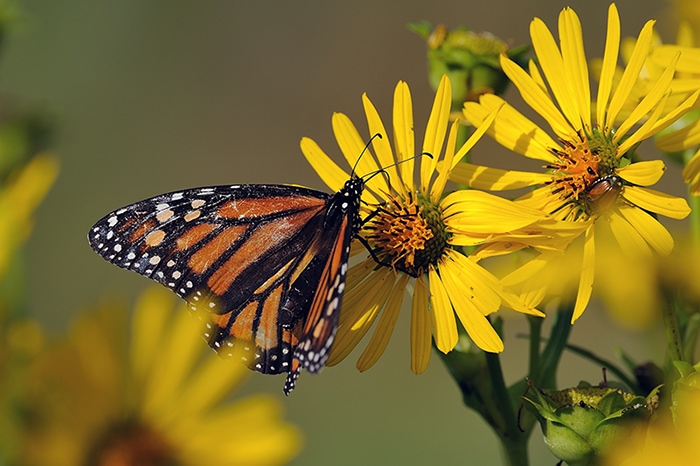
Cup plant (Silphium perfoliatum) and a worn but beautiful monarch.
Photo by JanetandPhil/flickr/cc.
Cup Plant (Silphium perfoliatum)
Height: 3 – 8 ft
Bloom time: July – September
Sun: Full
Moisture: High, Medium
Soil: Rich, adaptable
Natural Habitat: Floodplain forests, alluvial clearings, low meadows
Notes: The large clasping leaves form ‘cups’ that collect water.
A prolific reproducer.
Birds enjoy the seeds, and the thick hollow stems make excellent nests for native bees.
Host to four species of Lepidoptera.
Shrub bonus!

A spicebush butterfly on a buttonbush flower sphere (Cephalanthus occidentalis). The spicebush caterpillar requires the leaves of its host plants, spicebush (Lindera benzoin) and sassafras (Sassafras albidum). Photo by John Flannery/flickr/cc.
Buttonbush (Cephalanthus occidentalis)
Height: 6 – 12 ft and up
Bloom time: June – August
Sun: Full, Part
Moisture: High, Medium
Soil: Poor, sand, clay
Natural Habitat: Marshes, tidal shrublands, open swamps, floodplain pools, depression ponds, usually in seasonally or semi-permanently flooded habitats
Notes: Typically grown as a small tree; the long-lasting flowers attract a multitude of insects.
Nineteen species of Lepidoptera are hosted on Cephalanthus.
More information: Master Gardeners of Northern Virginia: Buttonbush
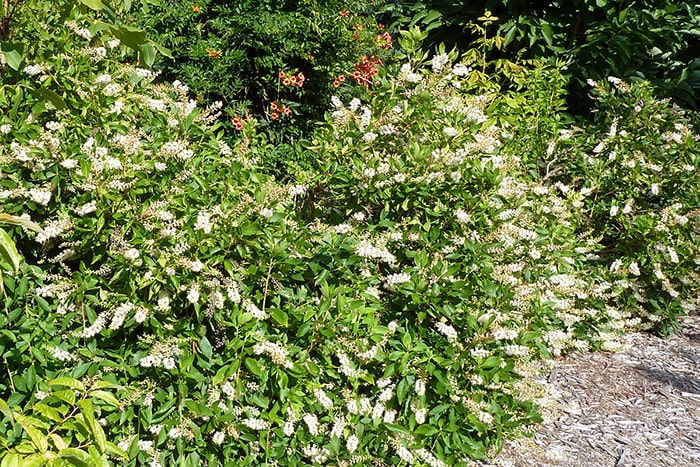
Sweet pepperbush (Clethra alnifolia) has fragrant wands of flowers that attract oodles of pollinators. Photo by Wendy Cutler/flickr/cc.
Sweet Pepperbush (Clethra alnifolia)
Height: 3 – 6 ft, up to 12 ft
Bloom time: July – August
Sun: Part, Shade
Moisture: High, Medium
Soil: Adaptable, sand, clay; pH acid
Natural Habitat: Mesic to rather dry, acidic upland forests, wet flatwoods, seepage swamps, and bogs
Notes: The leaves emerge late in spring; lovely yellow fall color.
Clethra hosts 9 species of native butterflies and moths.
More information: Virginia Native Plant Society 2015 Wildflower of the Year: Sweet Pepperbush
Resources & Information:
Digital Atlas of the Virginia Flora
Lady Bird Johnson Wildflower Center
Albemarle County, Virginia: Piedmont Native Plants
The Xerces Society: Mid-Atlantic Region Pollinator Plants
The Xerces Society: Mid-Atlantic Monarch Butterfly Nectar Plants
Virginia Native Plant Society: Wildflowers for Butterfly Gardens
Maryland Native Plant Society: Using Native Plants to Attract Butterflies
Northern Woods: The Butterflies of Winter
Research: Butterfly nectaring flowers: Butterfly morphology and flower form
